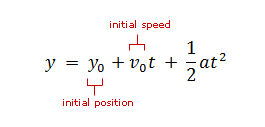|
by
kirupa | 10 February 2009
In the
previous page, you saw what it takes to make your ball
fall. That is only half the story. In this page, let's look
at what it takes to cause the fallen ball to rise back up.
Let's
continue looking at the code from where we left
off...starting with the startRisingBall method:
- // Sets up what is needed to
start bouncing the ball up
- function
startRisingBall()
{
- initialSpeed=decay*Math.sqrt(2*Math.abs(finalPos-initialPos));
- timer=0;
- currentPos=this.y;
- this.addEventListener(Event.ENTER_FRAME,
moveBallUp);
- }
The startRisingBall method is responsible for taking your
ball from the bottom and moving it to the top. Like I
explained a few pages ago, the speed your ball has as your
bouncing up is exactly the same speed it had when it fell to
the ground. The equation for that is what you saw earlier:

Because of conservation of energy, if the same speed was
used, that would mean your ball would be bouncing
indefinitely, so I introduce a decay value that I briefly
talked about to dampen the speed a bit. Putting it all
together, you get the following line of code:
- initialSpeed=decay*Math.sqrt(2*Math.abs(finalPos-initialPos));
The final deed the startRisingBall method does is just
resetting some of our variables to start the ball moving up. Because I am treating
the up movement as a separate, independent action, I reset
my timer and
currentPos to 0 and my ball's current position
respectively.
The final thing this method does is set up the animation
by registering the ENTER_FRAME event with the moveBallUp
event handler...which we'll look at next.
- // Responsible for moving the
ball up
- function
moveBallUp(e:Event)
{
- timer+=1;
-
- //Storing the position of
the ball before and after it moves
- var
positionA:Number=this.y;
- this.y
=
currentPos -
initialSpeed*timer
+ .5*gravity*(timer
*
timer);
- var
positionB=this.y;
-
- checkTopBoundary(positionA,
positionB);
- }
The moveBallUp event is the arch-nemesis of your
moveBallDown method. This method gets called at each
ENTER_FRAME event,
and it is responsible for moving the ball up. It does this
by first incrementing the timer and then setting the current
position to our favorite equation for position:

The line of code mapping to the above diagram is:
- this.y
=
currentPos -
initialSpeed*timer
+ .5*gravity*(timer
*
timer);
The only difference now is that the initialSpeed actually
matters. That is why it is visible in the code whereas it
was omitted in its counterpart for making the ball fall
earlier.
The last thing is to make a call to the
checkTopBoundary method that takes
positionA and
positionB as
arguments. Notice that the positionA and positionB variables measure
the position of the ball before and after it gets moved.
While this sounds odd, I
am doing this to figure out whether the ball is still moving
up or whether the ball's direction has changed.
- // Checks when the ball has
hit the top of the bounce
- function
checkTopBoundary(firstPos:Number,
secondPos:Number)
{
- if
(secondPos>firstPos)
{
- stopRisingBall();
- startFallingBall();
- }
- }
While I gave some of details away in the preceding
section, I check the direction of the ball movement in the
checkTopBoundary method. The reason is that, if I didn't
check the direction, the ball would automatically reverse
direction and start moving down. I already have code
dedicated to making the ball fall! You spent an entire page
looking it. Instead, by comparing whether the
secondPos is greater than the
firstPos, I can stop the
current animation and switch to all of the code you saw
before for making the ball fall.
If the second position is greater than the first
position, I
immediately call both the stopRisingBall and
startFallingBall methods! As
their names apply, one method stops the ball from rising,
and the other method starts the ball falling. Phew. You are
almost done. Let's just jump back up in our code to look at
the variables you have declared.
- var
timer:Number=0;
- var
initialPos:Number=0;
- var
finalPos:Number=0;
- var
currentPos:Number=0;
- var
initialSpeed:Number=0;
- var
startPosition:Number=0;
- var
gravity:Number
= 1;
-
- //Adjust this to increase or
decrease the
- //number of bounces
- var
decay:Number
= .9;
The variables at the vary top help keep track of the
various things that help your ball either fall or bounce.
The most important variable is the one for decay. This decay
variable is used to dampen the bounce each time your ball
hits the ground. A really small value for decay means that
the bouncing will stop very quickly. A larger value (such as
.95 or .99) indicates that the bounce will go on a bit
longer. A value of 1 means the bouncing will continue
indefinitely. This would be the ideal case where energy is
perfectly conserved.
I hope you
found this tutorial useful. While the end result was a look
at the code that is responsible for making something bounce,
I think the more important part is understanding the physics
behind why the code is written the way it does. Best of all,
I probably brought back fond memories of you having seen
some of these concepts in your classes in the real world!
Just a final word before we wrap up. What you've seen here is freshly baked content without added preservatives, artificial intelligence, ads, and algorithm-driven doodads. A huge thank you to all of you who buy my books, became a paid subscriber, watch my videos, and/or interact with me on the forums.
Your support keeps this site going! 😇

|